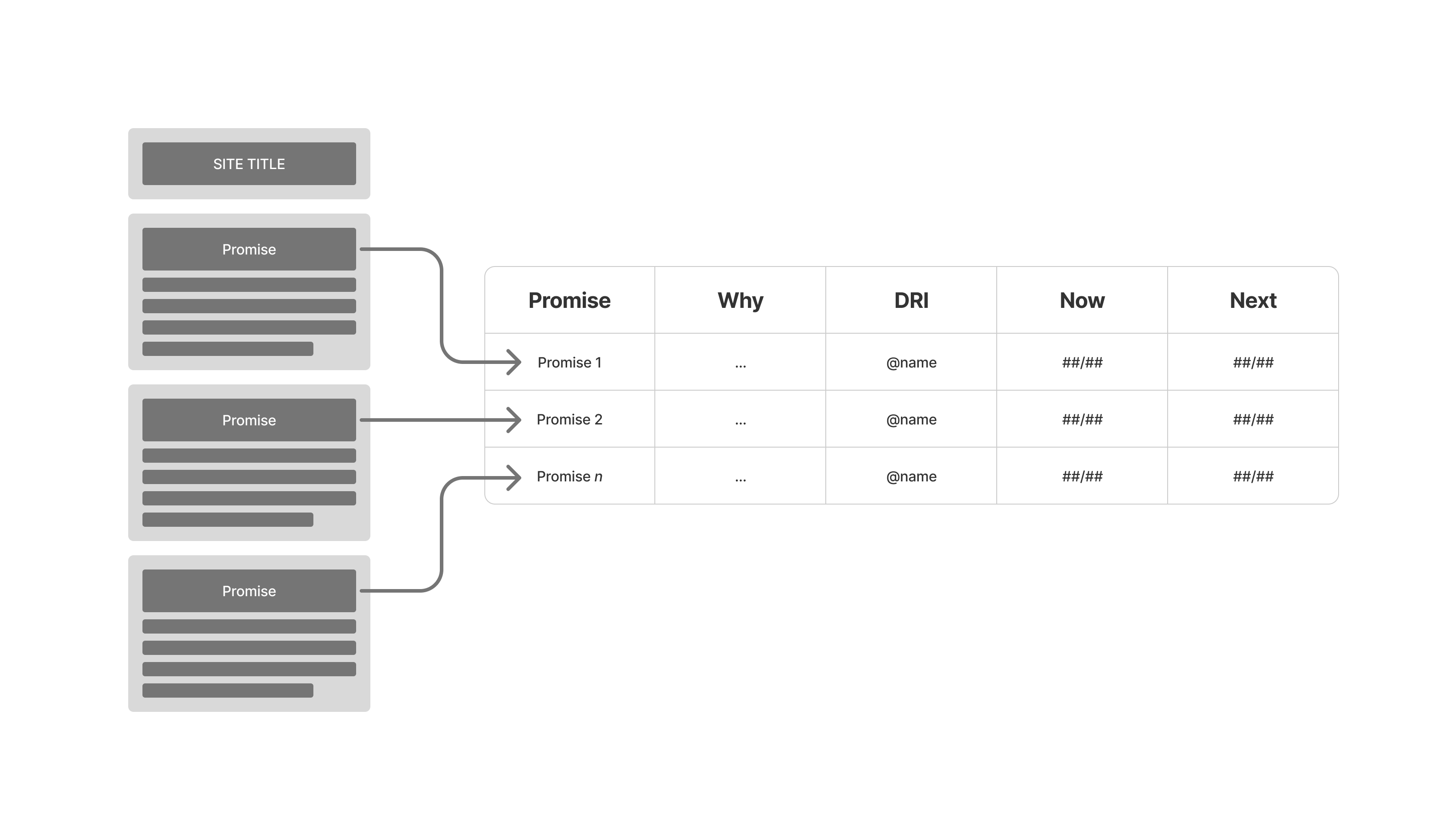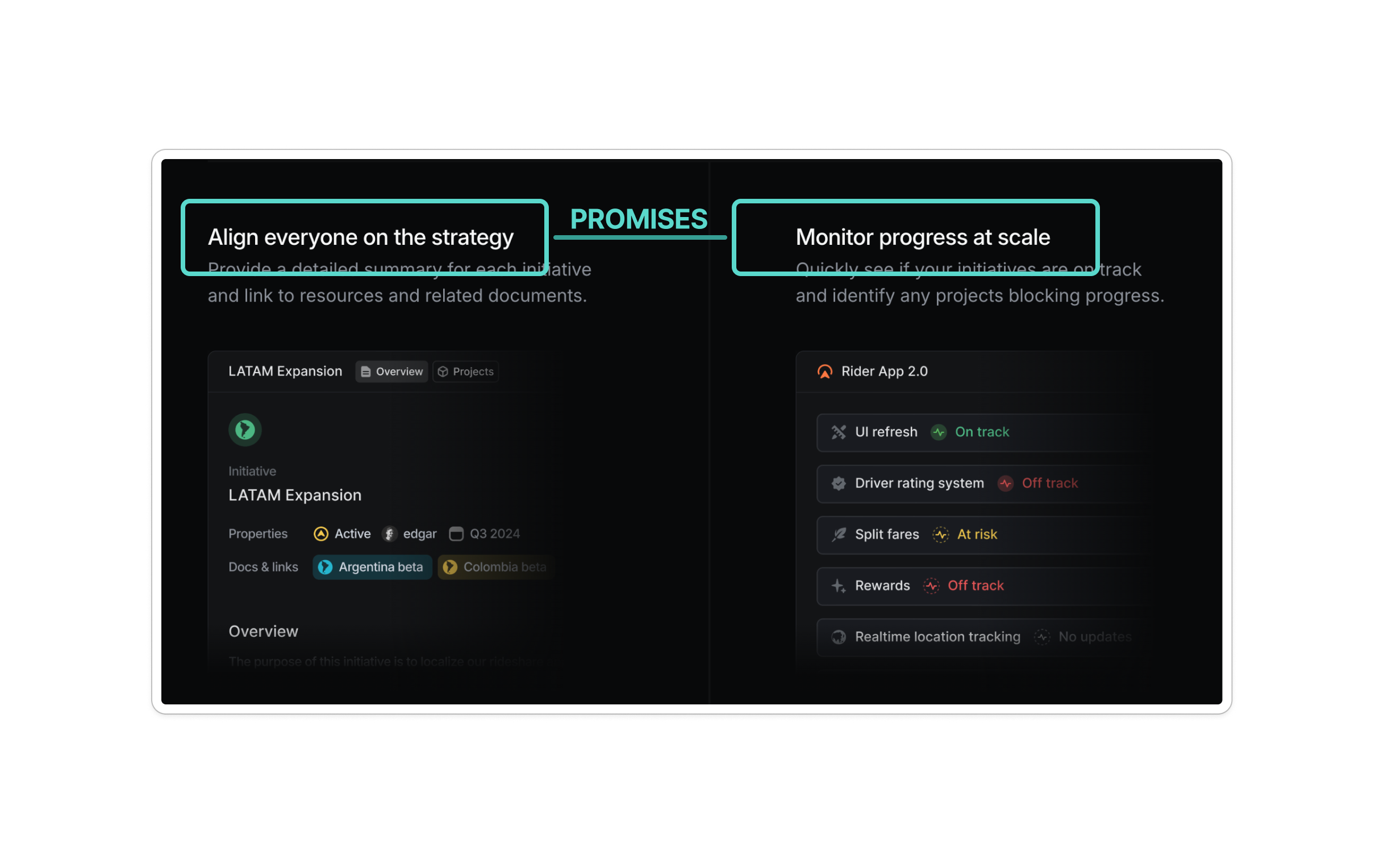Lightweight, Lasting Alignment

Alignment is a vital trait of high performing teams. Aligned teams:
- understand why they're doing what they're doing
- know who is responsible for determining tradeoffs
- know how to measure progress
- are skilled communicators within and beyond their immediate team
It can be difficult to do this all efficiently and – dare I say - enjoyably!
While this content is written from the perspective of a product lead, I find that many roles across a product company are “product minded.” So, I believe this will be relevant regardless of your title.
Let's start out by reviewing a classic scenario: Are we focused on the right problems?
Are we focused on the right problems?
Some of your most active users have requested an enhancement to your product. You've documented the needs, worked with your UX designers to craft a winning experience, tested with end users, refined, and validated the feasibility with your engineering lead. Nice!
You begin reviewing your plan with the rest of the team, and your marketing lead raises their hand:
Why are we building this? This makes no sense to me. We're not here to solve that problem 🤔
~Your favorite marketing lead
Have you wasted your time on solving the wrong problem? Have you been listening to the wrong - albeit vocal - users? Is your marketing lead out of touch with the evolving needs of customers?
Is your team going to lose faith in your leadership? Are you wasting their – and the company's time solving problems that ultimately don't matter?
This can be a frustrating, scary experience – especially if this occurs close to a marketed release date 😬
Let's explore a different approach that actively manages ongoing alignment so that we can more confidently pursue valuable, mission-aligned enhancements to our products and services.
Framework overview
This framework connects your product's promises to the product team's plans. Your prodocut promises can typically be found as headings on your markeeting site. Alternatives can include your Pitch Deck or PRFAQ. If you have none of those, I'd suggest huddling with your team to create a central resource you can use to prioritize and rationalize tradeoffs.
For the sake of this article, we'll assume you have a marketing site. We'll extract promises from your marketing site to help align product plans, and vice versa.

"If your website says one thing and your product does another, trust erodes fast. The market doesn’t care if your intentions were good."
— Julie Zhuo, “The Making of a Manager”
The steps for applying this framework are:
- Document the product promises from your marketing site (or Pitch Deck, PRFAQ, similar)
- Document the “why” of why each promise matters
- Document @who is responsible for this promise
- Document the now measurement that indicates current delivery on each promise
- Document the next measurement that indicates improvement on that promise
- Pick a cadence for
- reviewing progress toward the next goal - this could be weekly for fast-moving teams, monthly for enterprise products, or aligned to your release cycle cadence.)
- revalidating the company’s promises
- testing alignment between promises and current activities
- reviewing marketing alignment with those promises
You then use this content to democratize generation and prioritization of ideas that are relevant and strongly aligned to the journey from now to next.
Now that we’ve covered the gist of the approach, let’s dig in a bit.
Confirm Your Promises
For rapidly growing businesses, or businesses that are executing pivots of varying magnitude, it’s not uncommon for the marketing materials to become outdated. That actually doesn’t matter in the context of this exercise – but it might be a risk to your brand!
Review your marketing site and pull all of the content headings into a list. Then review and remove items that are purely structural or stylistic - you’re looking for statements that imply a market-facing promise.
You now have a good starting point for the “what are we promising to the market?” conversation. Grab time with marketing, customer success, growth and engineering colleagues. Review the list.
- Is there anything that seems to conflict with current plans?
- Is there anything that seems to conflict with what you’re hearing from users, customers, or prospects?
- What ideas, projects, features would you prioritize differently to better align with this list?
A wonderful potential outcome from this exercise is that the promises themselves become refined to better reflect the company’s actual purpose. Congrats! You’ve just demystified the foundation of the company’s product strategy, and have positioned all teams for better alignment toward progress that matters to your company and customers.
Here's an example of product promises from Linear:

Does this feel too abstract? It’s okay – I get it – let’s start connecting this more strongly so that the information becomes actionable.
Who's accountable?
“Accountability is not about blame, it’s about ownership.”
— Brene Brown
Teams need to know who is ultimately responsible for the decisions for a given product, product area, project, or plan. Without this clarity, decisions may take far too long, thereby reducing the speed of progress and learning for the team and company.
As shown above, we mitigate this potential through the specification of a Directly Responsible Individual for each promise. We now know who is responsible for setting the strategy to continually improve the company's ability to deliver on its promises in margin-enhancing, hard to copy ways. DRIs must stay close to evolving customer feedback and key metrics to keep efforts relevant and adaptive.
Great! Now we have validated our promises to market, and we have named individuals who are aware they’re responsible for ongoing progress for a given promise.
But ... how do we know we're moving in the right direction?
What are you measuring?
You can’t manage what you don’t measure — but if you measure the wrong thing, you’ll manage the wrong behavior.”
Clayton Christensen
Each DRI works with their teams to identify the key metrics for communicating progress in their respective promise. Some questions to help you identify metrics for your promise:
- Could a teammate explain this metric to a new hire in a few sentences?
- What are you trying to increase or decrease, by what amount, and over what timeframe?
- How strongly does this metric support the stated promise?
- What are the relevant use cases?
- What are the relevant user or buyer personas?
- What do you need from other teams in order to achieve the metric change you seek?
To maintain momentum and focus on progress instead of perfection, timebox the metric definition activity – for example, give teams 1 week to produce their initial metrics. As your team becomes more familiar with the metrics that matter, this may become a more fluid activity where you’re updating the key metric as new information surfaces vs. waiting for “the next planning cycle.”
Now, we can move on to selecting the bets that are most likely to move our metrics in a favorable direction.
How do we plan to improve?
Now that we know which metrics we’re trying to move, in what direction, over what timeframe, and why, we have some useful constraints to help us select ideas that matter.
In a world where ideas are flowing in from company employees, customers, end users, open source contributors, and more, it can be difficult to prioritize what do first, and why. How do we make a choice about what to pursue in an objective fashion?
With the constraints of specific metrics and specific movement and specific timeframe, we can evaluate ideas with those constraints!
- Can this idea be measured (not just shipped) within the timeframe?
- Does this idea apply to the relevant personas and use cases?
- How likely are we to succeed if our external-to-our-team dependencies fall through?
The conversation shifts from a subjective or emotional one to a more objective tone. Ideas more or less strongly support the movement of our defined metrics.
How are we managing progress?
We have identified our promises, DRI’s, metrics, and plans to move those metrics in favorable directions. Now it’s time to make moves!
Throughout the previous sections in this post, I’ve refrained from putting any sort of prescriptive process around the jobs to be done. Without a clear plan for ongoing alignment, foresight, feedback, and communication of all of that, these can feel like very disconnected activities. In all aspects of managing progress, seek to achieve the following goals:
Make the information collaborative and accessible
- Use Google Docs, Figma, Notion or Confluence to publish your content and the rationale for the selected now and next metrics
- Present your content to the broader company on a monthly basis
- Offer a live Q&A
- Create a slack channel for each promise where chatter can be centralized
- Respond to all comments and messages in a timely manner
Scale the plan and motivations
- Ask others to explain why the DRI is planning what they’re planning
- Have others on the team present updates to the company (not just the DRI!)
- Share relevant user and customer quotes in defined channels (e.g. Slack)
Automate feedback to the team and the company
- Use Looker Scheduled Reports to publish now/next metrics to the team slack on a weekly basis
- Set up threshold based notifications for the same to keep the team motivated toward the goal line
Be consistent
- Present the plan at least monthly in a live forum, offer live Q&A
- Talk to your personas weekly, and summarize what you hear into a doc, and share that doc with your team and in Slack
Tools that might help
While you certainly can cobble together various pieces of the framework in various manners, some teams have thought deeply to produce purpose built tooling for connecting the dots. Here are some options to get your started:
Composable options
- Looker (metric tracking) + Slack (topic-oriented chatter) + Notion (persistent documentation)
- Google Sheets - a great prototyping option, and long-term solution for some teams
Batteries-included options
- DoubleLoop - Connect Work to Business Outcomes
- Cascade Strategy: Strategy Software for Planning & Execution
Deeper dive into connecting company purpose to day-to-day tasks
Conclusion
“People don’t get burned out because of hard work. They get burned out because of a lack of meaning.”
Simon Sinek
Whether you’re seed stage or publicly traded, helping your teams clearly connect “what they’re doing” to the company strategy is not purely a means to focus – it’s a key motivator. Inspired teams are connected teams.
Where to go from here
If your team is scaling, shifting, or struggling to stay aligned on what matters most – we’d love to help. As product and user experience design leaders, we work with teams like yours to turn mission into movement, and strategy into execution.
Schedule a free initial chat with our team here.